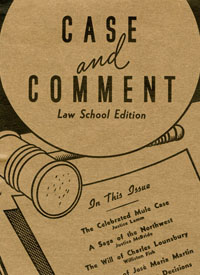 Index to Legal Periodical Literature, 1786-1937 (Jones & Chipman)
Index to Legal Periodical Literature, 1786-1937 (Jones & Chipman)

Editors: Leonard Augustus Jones (volumes 1 – 2), Frank Elsworth Chipman (volumes 3 – 6)
Publishers:
Boston Book Company, 1888-1919
Chipman Law Publishing Company, 1924
Bobbs-Merrill, 1933
Parker and Baird, 1939
Years Published: 1888 – 1939
Number of Volumes: 6
Scope: 1786 – 1937
Number of Citations in Database: 173,956
Types of Source Material Included:
abstract or summary, art reproduction, article, autobiography, bibliography, biography, essay, history, index, interview, journal, law report or digest, legal article, legal case and case notes, legislation, letter, manuscript, memoir, periodical, poetry, reporting, review, short story, statistics, treaty
First created by American judge Leonard A. Jones (1832 – 1909) in 1888 and continued by Frank E. Chipman (1861 – 1942), the Index to Legal Periodical Literature began as an index of pre-1886 legal literature. By the time it ended in 1937, it had expanded to index material on topics from sociology to economics.
Search nearly 174 thousand citations to periodical articles directly and tangentially related to legal matters in Jones and Chipman’s Index to Legal Periodical Literature, searchable via Eight Centuries.
The Index to Legal Periodical Literature first appeared in 1888 and was published until 1939. Its six total volumes purported to catalog all legal periodical literature from 1786 to 1937.1 At its outset, it represented the only comprehensive means of accessing legal articles in journals and magazines.2
Leonard A. Jones, a judge, editor, and author from Massachusetts, created the Index in 1888. Initially, it was an attempt to catalogue only articles on legal topics.3 Jones realized that there existed a trove of material relevant to law locked away in journals and magazines, which was almost inaccessible due to the lack of a comprehensive subject index. As Jones’s successor, Frank Chipman, characterized during a speech in 1920:
During the eighteenth century skilled workers began turning out a new product apparently designed for temporary use only. The great bulk of that product soon disappeared but a small quantity was saved and stored away in a separate room of a great warehouse. […] Later it was found that these products were of permanent value but access to them was difficult as there was no means of locating the particular piece wanted. […] It was not until the very close of the nineteenth century that a master workman was found that had the ability and courage to undertake the making of a key that would unlock the practically sealed door of the warehouse and give access to the accumulations of a hundred or more years.4
Of course, the “new product” was the magazine, the courageous “master workman” was Jones himself, and the miraculous “key” that finally allowed access to over a century of source material was his Index.5
Though Jones was early to the burgeoning field of periodical indexing, he did use a predecessor index as a basis when creating his work: William F. Poole’s foundational Index to Periodical Literature. Poole’s work was the earliest attempt at indexing the vast field of periodical literature that appeared in the nineteenth century.6 Jones wrote in the preface to the first Index volume in 1888 that he was “much indebted to Mr. Poole’s admirable Index.”7
Like Poole’s own project—which sought to index the majority of periodical literature—the scope of Jones’s work was almost Sisyphean. As he laid out in his 1888 preface:
One hundred and fifty-eight different law journals and reviews have been indexed; and also the articles relating to matters of law and legislation, and to biographies of judges and lawyers, in one hundred and thirteen of the principal American, British, and Colonial literary magazines and reviews. The number of volumes of law periodicals indexed is thirteen hundred and seventy-three; and the articles pertaining to law and legislation in upwards of forty-four hundred volumes of literary and historical periodicals, are also included.8
Despite the wide net cast by the first volume, Jones decided to expand his scope further for the Index’s second volume. He realized that lawyers may have a professional interest in subjects beyond pure law, and he began to assert hidden connections between the realm of law and other fields through his indexing.
Published in 1899, this volume’s coverage went beyond purely judicial matters: it included works on economics, sociology, and political science alongside those on jurisprudence.9 To explain his inclusion of seemingly disparate fields in a legal index, Jones included a quote from Yale economist Arthur Hadley in the preface to the second edition:
The fundamental datum of modern economics is property right. This is also the datum and starting point of a large part of our legal reasoning. The method of the economist is a combination of the historical and the deductive. He studies the precedent by which property right has been established on the one hand, and deduces the consequences arising from such property rights on the other hand. This combination is also characteristic of the methods of the Judiciary; the chief difference between economists and court being that the economist considers how the individual judgement will act under the given conditions, while the court considers how the public judgement will act.10
Jones recognized the strong connections that exist between the judiciary and fields like economics and sociology, and he crafted his index to reflect these ties.
Alas, the second volume was the last Jones would produce. Jones died in 1909 and for ten years the Index lay dormant, assumed to be a finished work. Finally, Frank E. Chipman took over editorship of the index and a third volume appeared in 1919. Chipman would continue as editor until the publication of the sixth and final volume in 1937. By the end, the Index covered over 150 years of literature and contained a total of 173,956 citations.
Sample research topics addressed by Jones and Chipman’s Index to Legal Periodicals searchable via Eight Centuries:
(“Bicycle Legislation,” National Corporation Reporter, volume 12, 1897, p. 495)
(“Is Christianity a part of the law?,” Canada Law Journal, volume 46, 1910, p. 81)
(Lewis G. Janes, “Economic Value of Altruism,” Social Economist, volume 5, 1895, p. 11)
What is the history of the legislation of morality in Western Europe?
(“Laws against Immorality,” Legal Observer, volume 25, 1843, p. 187)
(Lewis Tupper, “Sociology and Comparative Politics,” Journal of the Society of Comparative Legislation, volume 9, 1908, p. 142)
(E. Peck, “Women's Rights in a Male-Suffrage State,” Yale Law Journal, volume 25, 1916, p. 459)
[1] Eugene P. Sheehy, Guide to Reference Books, 10th ed. (Chicago and London: American Library Association, 1986), 910.
[2] Frank E. Chipman, “The Opening of Sealed Doors,” Law Library Journal 13, no. 3 (October 1920), 62: https://books.google.com/books?id=kTVFAQAAMAAJ.
[3] In addition to creating his Index, Jones was the editor of the American Law Review from 1884 until 1907. “Notes of Current Topics,” American Law Review 41 (1907): 111, https://hdl.handle.net/2027/njp.32101065402461.
[4] Chipman, 1920.
[5] Ibid.
[6] Poole’s Index to Periodical Literature is also available to search in Eight Centuries. For more information about this remarkable resource, see its resource description.
[7] Leonard A. Jones, “Preface,” An Index to Legal Periodical Literature (Boston: The Boston Book Company, 1888), v.
[8] Jones, “Preface,” 1888, vi.
[9] Leonard A. Jones, “Preface,” An Index to Legal Periodical Literature Vol. II., 1887-1899 (Boston: Boston Book Company, 1899), v.
[10] Quoted in Jones, 1899. Arthur Hadley, “The Relation Between Economics and Politics,” Economic Studies 4, no. 1 (February 1899): 16, https://books.google.com/books?id=Rp5DAQAAMAAJ.